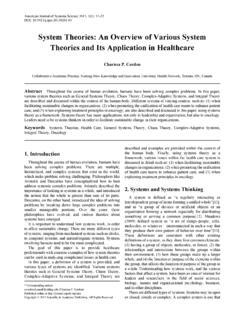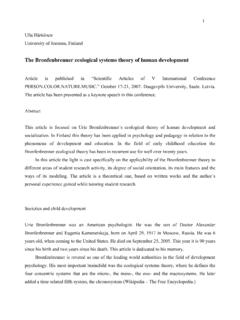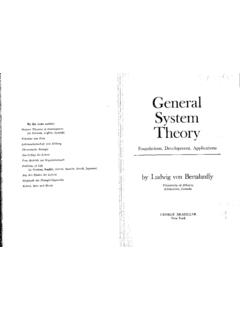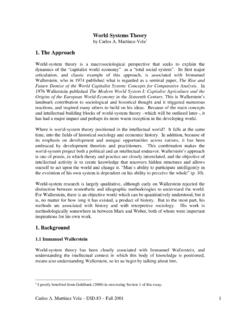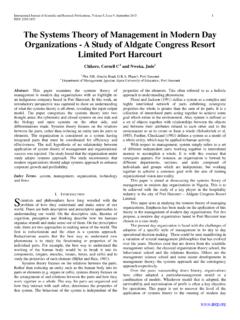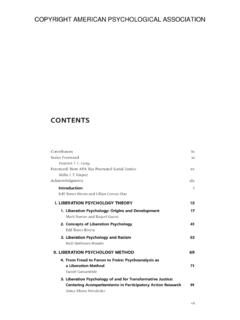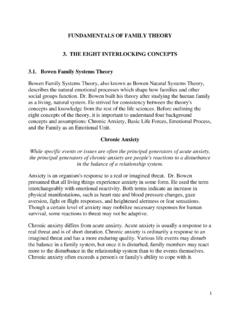Transcription of The Impact of Organizational Theory and Organizational ...
1 The Impact of Organizational Theory and Organizational Learning on Organizations This essay explores Organizational Theory , its history and development as an academic principle and its Impact on organizations. The essay will review the works of various theorists in the field of Organizational Theory , exploring how they have influenced Organizational Theory , the ways in which Organizational Theory classifies knowledge, the insight gained from the knowledge of Organizational Theory and the Impact of Organizational Theory on organizations.
2 Lastly, this essay will review the application of learning by organizations and the effects of learning on the growth of an organization . Westley defines an organization as a series of interlocking routines and habituated action patterns that bring the same people together around the same activities in the same time and place (339). The International Encyclopedia of the Social Sciences defines Theory as a supposition or system of ideas explaining something, especially one based on general principles independent of the particular things to be explained.
3 Organizational Theory is defined as the study of organizations and Organizational structures, the study of relationships of organizations with their external environments, as well as the study of the behavior of managers and their subordinates within organizations. Organizational Theory provides insight into the group and individual dynamics that are in play in organizations, understanding and modeling the factors created by these dynamics to postulate theories that guide society as a whole and organizations in particular. Organizational Theory is that merger of bureaucratic Theory , scientific management, and administrative Theory that seeks to explain organizations and the structures and processes that operate within them (Walonick, 1).
4 Bureaucratic Theory , postulated by Max Weber, emphasizes a need for hierarchical structure of power, recognizing the division of labor and specialization. Weber s Theory is based on the notion that Organizational behavior is a network of human interactions, where all behavior could be understood by looking at cause and effect (Walonick, 1). Scientific management is the Theory of Organizational management that analyzes and systemizes workflows to increase labor productivity and economic efficiency defined by Frederick Taylor in 1917.
5 Scientific management (also called Taylorism) operates off four principles: 1) find the best way to perform each task, 2) match each worker to a task, 3) closely supervise workers, using reward and punishment as motivators, and 4) management s task is to plan and control (Walonick, 1). Administrative Theory is a principle of management that emphasizes a universal set of management principles that could be applied to all organizations (Walonick, 1). Hatch and Cunliffe identified the principles of administrative Theory to include: span of control number of subordinates managed by one manager, departmentation grouping similar activities, unity of command one person-one boss, and scalar principles linking Organizational members in a hierarchy.
6 Combining all three theories, Organizational Theory focuses on the interactions within organizations, the ways in which organizations adapt, as well as the strategies and structures guiding them. Historical Background of Organizational Theory Although it did not emerge as an academic field until the 60 s, it is possible to trace Organizational Theory back to 1776 when Adam Smith advocated a new form of Organizational management called division of labor. Adam Smith s division of labor was followed a century later by Max Weber s Theory of bureaucracy, Frederick Taylor s scientific management and Henry Fayol s administrative Theory .
7 Before its acceptance as a field of study in the 1960s, Organizational Theory was making contributions to classifications in Organizational management. Prior to the 60s, authors who wrote about what later became accepted as concepts of Organizational Theory had their own disciplinary communities to which they were oriented when they wrote (Hatch and Cunliffe, 7). Adam Smith (division of labor), was a political economist; Karl Marx, ( Theory of capital, managerial control, exploitation and alienation) was one of the founders of sociology; Emile Durkheim (formal and informal organization ) was a sociologist; Frederick Taylor (scientific management) was an engineer, and Mary Parker Follet (principle of self-government of groups) was a social reformer and consultant.
8 The concepts put forward by these theorists impacted not only what later became known as Organizational Theory but also the theorists own respective fields. These concepts, in later years, became reference points around which Organizational Theory developed further. For instance, in reaction to the rigid, authoritative bureaucratic and scientific management approaches to Organizational management, Chester Barnard, in 1938 proposed the first new Theory of organization : organizations are cooperative systems, not the products of mechanical engineering (Perrow, 4).
9 Barnard stressed the need for natural groups within the organization , upward communication, authority from below rather than from above and leaders who functioned as a cohesive force. This human relationship management approach to Organizational Theory draws its inspiration from biological and not engineering systems, fostering relationships between employees and employers that go beyond rigid control. This view of Organizational management is what is seen in practice in today s modern organization . Organizational Theory has evolved from the tough authoritarian structure of the classical era during which it was believed that people are motivated to work strictly for economic reward to the neoclassical which addresses the rigidity of the classical but is faulted for stifling creativity, to the contingent which addresses conflicts avoided by the neoclassical and believes that an organization would evolve to meet the needs of its strategy.
10 That form follows function to the systematic which believes that all the components of an organization are interrelated, and that changing one variable might Impact many others (Walonick, 2-3). At each stage of its evolution, Organizational Theory has been guided by the insights postulated and by Organizational theorists and authors. Ontology and Epistemology of Organizational Theory Since the emergence and acceptance of Organizational Theory as a major field of study, Organizational theorists have refined conceptual distinctions, using them to create sophisticated explanations for individual and group dynamics that exist within an Organizational setting (Hatch and Cunliffe, 4).
